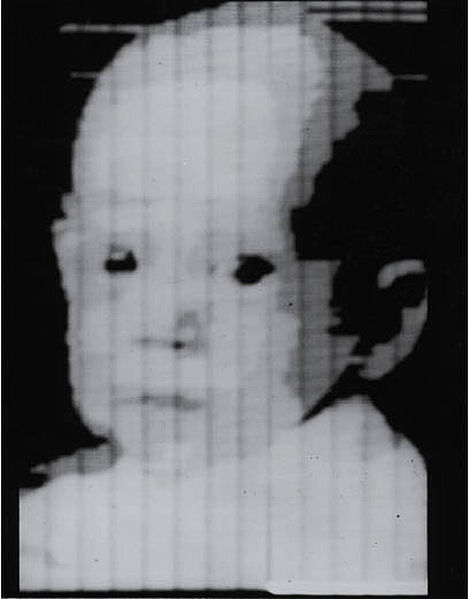The Scanner Story
Image scanner: A scanner is a device which uses optical technology to capture a document and create a two-dimensional image which can be stored on a computer.
Scanning The scanning process can be described as the procedure of converting hard copies, such as paper document and films, into a digital form that than can be preserved for a long time as well as transferred over long distances. They are widely used today in both commercial and domestic settings to create digital copies of photographs, documents and a range of other items. Scanners are useful in our day-to-day lives. One can transfer images across long distances by scanning and emailing them. The image scanners were considered to be useful gadgets before the development of digital cameras. Scanners are considered to have evolved from the early telephotography input devices, which consisted of a rotating drum with a single photo detector at a standard speed of 60 or 120 rpm (later models up to 240 rpm). They sent a linear analog AM signal through standard telephone voice lines to receptors, which synchronously printed the proportional intensity on special paper. In computing, a scanner is a device that optically scans images, printed text, handwriting, or an object, and converts it to a digital image. Common examples found in offices are variations of the desktop (or flatbed) scanner where the document is placed on a glass window for scanning. Hand-held scanners, where the device is moved by hand, have evolved from text scanning "wands" to 3D scanners used for industrial design, reverse engineering, test and measurement, orthotics, gaming and other applications. Mechanically driven scanners that move the document are typically used for large-format documents, where a flatbed design would be impractical. Modern scanners typically use a charge-coupled device (CCD) or a Contact Image Sensor (CIS) as the image sensor, whereas older drum scanners use a photomultiplier tube as the image sensor. A rotary scanner, used for high-speed document scanning, is another type of drum scanner, using a CCD array instead of a photomultiplier. Other types of scanners are planetary scanners, which take photographs of books and documents, and 3D scanners, for producing three-dimensional models of objects. Scanners can be considered the successors of early telephotography input devices, consisting of a rotating drum with a single photodetector at a standard speed of 60 or 120 rpm (later models up to 240 rpm). They send a linear analog AM signal through standard telephone voice lines to receptors, which synchronously print the proportional intensity on special paper. This system was in use in press from the 1920s to the mid-1990s. Color photos were sent as three separated RGB filtered images consecutively, but only for special events due to transmission costs.
Even though they don’t have that long a history compared to other gadgets available on the market, image scanners have evolved a lot since their beginnings, now being available as flatbed scanners, planetary scanners or digital camera scanners, with a wide variation of designs and functions.
The functioning of these models can be described as follows. The devices that operated on telephotography technique, had components such as rotating drums. These drums had a photo detector attached to them. The drums rotated at 60 or 120 rotations per minute (rpm) speed. The models that were used later had the drums with 240 rpm speed.The analog AM signals sent through the telephone lines were detected by receptors. These receptors, then printed the image on a specially prepared paper in accordance with the signals received. This technique of imaging was used by the newspapers for a period of around 70 years between the 1920s and 1990s. Color images were sent using the ‘RGB filter’ technique. However, use of this technique was a costly affair thus, the newspapers rarely sent color images.
The first scanners were drum copiers, capturing information with photomultiplier tubes. Items to be scanned are mounted on a cylinder which rotates. This drum is passed in front of the optical equipment which captures the image. Drum scanners are still used, as they enable capture of very high quality images, up to 12,000 PPI (pixels per inch) and they are often used in film work. They are very expensive, ranging from tens of thousand of dollars to a hundred thousand.
 The first image scanner ever developed was built in 1957, at the US National Bureau of Standards (now the National Institute of Standards and Technoloyg or NIST), by a team led by Russel Kirsch. The first image to be scanned was a photograph of three month old Walden Kirsch, captured in 1957 at the National Bureau of Standards. The picture was created using a drum scanner. The black and white image had a resolution of 176 pixels in terms of resolution, and had a size of 5 square cm. It was a defining moment in the history of the development of image scanners.
The first image scanner ever developed was built in 1957, at the US National Bureau of Standards (now the National Institute of Standards and Technoloyg or NIST), by a team led by Russel Kirsch. The first image to be scanned was a photograph of three month old Walden Kirsch, captured in 1957 at the National Bureau of Standards. The picture was created using a drum scanner. The black and white image had a resolution of 176 pixels in terms of resolution, and had a size of 5 square cm. It was a defining moment in the history of the development of image scanners.
Scanners have slowly developed into the modern devices that we use today, going through a variety of models and several scanning technologies that have resulted into multiple types of image scanners.
Early scanning systems were in use in press from the 1920s to the mid-1990s. Color photos were sent as three separated RGB filtered images consecutively for special events only due to transmission costs.
 Most scanners incorporate the capability for optical character recognition, or OCR. This technology was first developed in the 1920’s. However, it wasn’t until the 1950’s that the technology began to be used in earnest. In 1976 Ray Kurzweil unveiled the first device which could scan text and convert it into speech, making print accessible to the blind. His device included the first flatbed scanner.
Most scanners incorporate the capability for optical character recognition, or OCR. This technology was first developed in the 1920’s. However, it wasn’t until the 1950’s that the technology began to be used in earnest. In 1976 Ray Kurzweil unveiled the first device which could scan text and convert it into speech, making print accessible to the blind. His device included the first flatbed scanner.
Photocopiers and scanners share a common history, as there is considerable similarity between them. Flatbed scanners and photocopiers both have a glass plate on which the subject is laid, and both create a copy which can be either digital or hardcopy. However, the similarity is not as close as it appears – early photocopiers were analog devices which only produced a hardcopy result, and a scanner only produces digital output. Photocopying technology was developed during the 1940’s, with the first copier going on sale in 1949.
The more common examples that are found in offices are variations of the flatbed (desktop) scanner, but hand-held scanners also have evolved from text scanning wands to 3D scanners, being more and more used in industrial design, reverse engineering, test and measurement, orthotics, gaming and other applications. Also available are mechanically-driven scanners that move the document and they are used for large-format documents, where a flatbed scanner would be impractical.
The key-element of modern scanners is that they use a charge-coupled device (CCD) or a Contact Image Sensor (CIS) as the image sensor, unlike older drum scanners, which use a photomultiplier tube as the image sensor. Other types of scanners are planetary scanners, which take photographs of books and documents, and the 3D scanners, which produce three-dimensional models of objects.
Also, there are digital camera scanners that are based on the concept of reprographic cameras, offering advantages such as speed, portability, gentle digitizing of thick documents without damaging the book spine. But new scanners have taken it a little further, combining 3D scanners with digital cameras to create full-color, photo realistic 3D models of objects.
Another important parameter for a scanner is its density range. A high density range means that the scanner is able to reproduce shadow details and brightness details in one scan.
Scanning the document is only one part of the process. For the scanned image to be useful, it must be transferred from the scanner to an application running on the computer. There are two basic issues: 1 – how the scanner is physically connected to the computer and 2 – how the application retrieves the information from the scanner.
The amount of data generated by a scanner can be very large: a 600 DPI 9"x11" uncompressed 24-bit image is about 100 megabytes of data which must be transferred and stored. The size of the file created increases with the square of the resolution; doubling the resolution quadruples the file size. A resolution must be chosen that is within the capabilities of the equipment, preserves sufficient detail, and does not produce a file of excessive size. The file size can be reduced for a given resolution by using "lossy" compression methods such as JPEG, at some cost in quality. If the best possible quality is required lossless compression should be used; reduced-quality files of smaller size can be produced from such an image when required (e.g., image designed to be printed on a full page, and a much smaller file to be displayed as part of a fast-loading web page). Recent scanners can generate this volume of data in a matter of seconds, making a fast connection desirable. Manufacturers often claim interpolated resolutions as high as 19,200 ppi; but such numbers carry little meaningful value, because the number of possible interpolated pixels is unlimited.
Quality Scanners typically read red-green-blue color (RGB) data from the array. This data is then processed with some proprietary algorithm to correct for different exposure conditions, and sent to the computer via the device’s input/output interface (usually SCSI or bidirectional parallel port in machines pre-dating the USB standard). Color depth varies depending on the scanning array characteristics, but is usually at least 24 bits. High quality models have 48 bits or more color depth. The other qualifying parameter for a scanner is its resolution, measured in pixels per inch (ppi), sometimes more accurately referred to as Samples per inch (spi). Instead of using the scanner’s true optical resolution, the only meaningful parameter, manufacturers like to refer to the interpolated resolution, which is much higher thanks to software interpolation. As of 2009, a high-end flatbed scanner can scan up to 5400 ppi and a good drum scanner has an optical resolution of 12,000 ppi.
Scanners communicate to their host computer using one of the following physical interfaces, listing from slow to fast:
Parallel – Connecting through a parallel port is the slowest common transfer method. Early scanners had parallel port connections that could not transfer data faster than 70 kilobytes/second. The primary advantage of the parallel port connection was economic: it avoided adding an interface card to the computer.
GPIB – General Purpose Interface Bus. Certain drumscanners like the Howtek D4000 featured both a SCSI and GPIB interface. The latter conforms to the IEEE-488 standard, introduced in the mid ’70’s. The GPIB-interface has only been used by a few scanner manufactures, mostly serving the DOS/Windows environment. For Apple Macintosh systems, National Instruments provided a NuBus GPIB interface card.
Small Computer System Interface (SCSI) – which is supported by most computers only via an additional SCSI interface card. Some SCSI scanners are supplied together with a dedicated SCSI card for a PC, although any SCSI controller can be used. During the evolution of the SCSI standard speeds increased, with backwards compatibility; a SCSI connection can transfer data at the highest speed which both the controller and the device support. SCSI has been largely replaced by USB and Firewire, one or both of which are directly supported by most computers, and which are easier to set up than SCSI.
Universal Serial Bus (USB) – scanners can transfer data quickly, and they are easier to use and cheaper than SCSI devices. The early USB 1.1 standard could transfer data at only 1.5 megabytes per second (slower than SCSI), but the later USB 2.0 standard can theoretically transfer up to 60 megabytes per second (although everyday rates are much lower), resulting in faster operation.
FireWire – is an interface that is much faster than USB 1.1 and comparable to USB 2.0. FireWire speeds are 25, 50, and 100, 400 and 800 megabits per second (but a device may not support all speeds). Also known as: IEEE-1394.
Applications Interface
An application such as Adobe Photoshop must communicate with the scanner. There are many different scanners, and many of those scanners use different protocols. In order to simplify applications programming, some Applications Programming Interfaces ("API") were developed. The API presents a uniform interface to the scanner. This means that the application does not need to know the specific details of the scanner in order to access it directly. For example, Adobe Photoshop supports the TWAIN standard; therefore in theory Photoshop can acquire an image from any scanner that also supports TWAIN. In practice, there are often problems with an application communicating with a scanner. Either the application or the scanner manufacturer (or both) may have faults in their implementation of the API.
Bundled applications
Although no software beyond a scanning utility is a feature of any scanner, many scanners come bundled with software. Typically, in addition to the scanning utility, some type of image-editing application (such as Photoshop), and optical character recognition (OCR) software are supplied. OCR software converts graphical images of text into standard text that can be edited using common word-processing and text-editing software; accuracy is rarely perfect.
Infrared cleaning
Infrared cleaning is a technique used to remove dust and scratches from film, and most modern scanners incorporate this feature. It works by scanning the film with infrared light. From this, it is possible to detect dust and scratches that cut off the infrared light; and they can then be automatically removed, by considering their position, size, shape, and surroundings. Scanner manufacturers usually have their own name attached to this technique. For example, Epson, Nikon, Microtek, and others use Digital ICE, while Canon uses its own system FARE (Film Automatic Retouching and Enhancement system). Some independent software developers are designing their own infrared cleaning tools.
Although the evolution of scanners may not be as spectacular as that of TVs, let’s say, important improvements have been added along they years and there’s probably much more to come and change the face of scanning technology as we know it. The perishable nature of paper made it difficult to preserve documents and hence, image scanners can be included in some of the path-breaking inventions of the 20th century. The history of image scanners that we use today, can be traced back to the period when telephotography was used to transfer images from one place to other. Telephone lines were used as a medium in telephotography.
